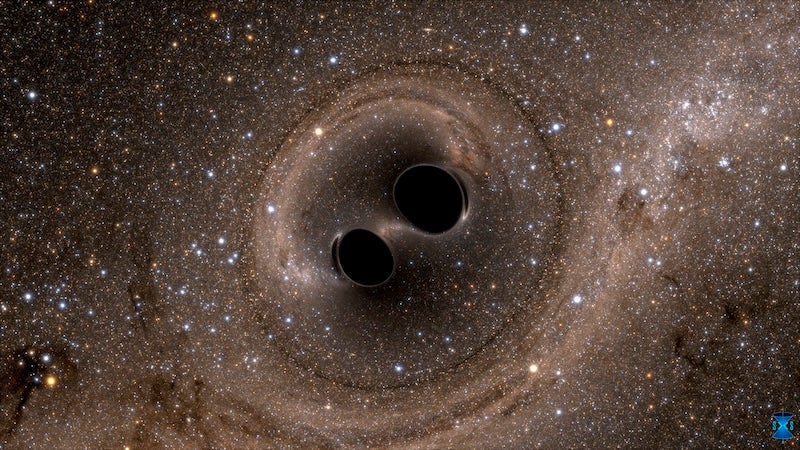
When black holes merge, does the actual diameter of the new black hole increase, or just its mass?
Richard Robinson
Clay, New York
The short answer is yes: When two black holes merge, the resulting black hole has both more mass and a larger diameter. How much bigger? Let’s find out!
When astronomers talk about the size of a black hole, they’re talking about the size of its event horizon — the point of no return, beyond which even the speed of light is not sufficient to escape the black hole’s gravity. This is not a physical structure that you could touch, but a mathematical, spherical boundary. At its center lies the heart of a black hole: the singularity, which has mass but no volume.
For a simple, non-spinning black hole, the radius of the event horizon is also called the Schwarzschild radius, named for German physicist Karl Schwarzschild, who first worked out how big it would be. The Schwarzschild radius of a black hole, called rS, is given by the equation rS = 2GM/c2, where G is the gravitational constant (6.67 x 10-11 m3 kg-1 s-2), M is the mass of the black hole (in kilograms), and c is the speed of light in meters per second (3 x 108 m/s).
As a simple example, if we merge two black holes with the same mass and assume no mass is lost in the smash-up, we end up with a final black hole with twice the mass and also twice the radius of either of the two black holes that went into it.
It’s worth noting that in the real world, black holes can spin, and there are a whole host of other effects that ultimately impact the size and even way we would define a black hole’s “diameter.” Furthermore, some small fraction of the black holes’ mass is lost when they merge, radiated away as energy via gravitational waves. So, in practice, you always end up with a final black hole whose mass is generally not quite the sum of the two progenitor black holes combined.
Alison Klesman
Senior Editor
Hawking’s area theorem
When Stephen Hawking answered a similar question about black holes colliding in our December 1998 issue, he noted: “An interesting feature that I realized while I was getting into bed one night in 1970 is that the area of the event horizon, or boundary, of the final black hole has to be greater than the sum of the areas of the event horizons of the original black holes. This limits the amount of energy that can be radiated in gravitational waves and also suggested that the area of the event horizon is like the thermodynamic quantity entropy, a connection that was established when I later showed that black holes radiate like hot bodies.”
Called Hawking’s area theorem, this concept states that a black hole’s entropy — which is proportional to the area of its event horizon — cannot decrease. So, even if black holes can lose some small amount of mass during the merger, the final event horizon cannot have less area than the sum of the initial event horizons combined.
This theorem was developed some 45 years before the 2015 first detection of gravitational waves. A July 2021 paper in Physical Review Letters finally confirmed Hawking’s theorem observationally. In it, researchers reanalyzed the first gravitational-wave merger ever seen, called GW150914, and determined with 95 percent confidence that the area of the resulting black hole’s event horizon had not decreased compared to the event horizons of the progenitor black holes. — A.K.









